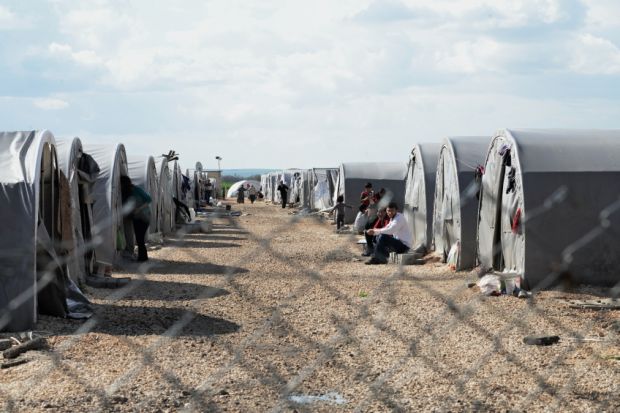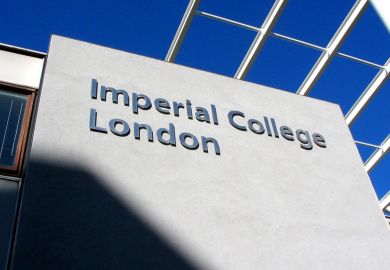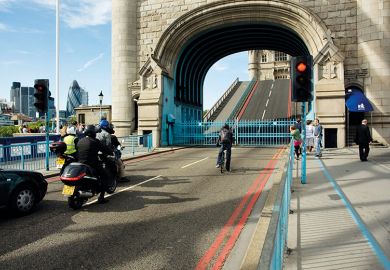Europe’s continuing refugee crisis has prompted a range of responses to ease the transition of displaced students into higher education. German universities will admit more than 50,000 Syrian students once they have been granted rights of asylum; the Institute for International Education (IIE) is building a network of universities that will offer places to refugees settling in North America; and similar initiatives are planned elsewhere.
But what of those who are not able to resettle in a host country? The United Nations estimates that the average time in an emergency camp is 17 years; older camps already have a university-aged generation who were born there and who have never left. Now that more than 50 million people across the world are displaced by conflict and violence, a condition of permanent transit will become common, requiring in turn new approaches to transnational education.
The needs prompted by these circumstances were acknowledged by Allan Goodman, president of the IIE, at a briefing in New York last week, organised in partnership with the German Academic Exchange Service (DAAD). The IIE stresses the importance of collaboration and plans to use its unique position to set up an international coordination service for initiatives.
By coincidence, the New York briefing coincided with the first deportations from Greece to Turkey in terms of the European Union’s new policy. This is also a time when the UN is focusing on all dimensions of existing policies and protocols for refugees, ahead of a General Assembly summit on 19 September. Here, the secretary-general is expected to conclude that the UN has failed to meet its obligations to refugees in terms of existing international law, and that new provisions are required. DAAD is pushing for these provisions to include all aspects of education.
The obstacles blocking the path to higher education are formidable for all refugees. But there is a widening gap between the prospects of those who manage to stay in host countries as their asylum applications and those either don’t make it out of the camps, or who are returned to them.
So far, most attention has been on those already in host countries. For example, Dorothea Rüland, DAAD’s secretary-general, maps out a four-stage process that starts with asylum formalities and the assessment of preparedness for university, and follows through with monitoring and mentoring as a refugee student is integrated into the German university system. In other countries, a growing number of universities are providing bursaries for refugee students who meet asylum conditions.
In contrast, there has yet to be a concerted focus on the education needs of those whose long term future is in the transit camps. The numbers of refugees in this situation are set to increase significantly: because of the scale of the current crisis; in terms of the EU’s “one in, one out” deal with Turkey; because the EU has capped the number of successful asylum applications; and because more than half of all refugees are children.
For young adults, every year spent in a transit camp waiting for permanent resettlement is a loss in educational opportunity. Alvaro Mendonça e Moura, Portugal’s permanent representative at the UN, stresses the need for policies that recognise the broader implications of such damage: loss of personal motivation; rising levels of criminality; inducement for radicalisation and diminishing capacity for post-conflict reconstruction. While middle and high-income economies are headed for an average of 50 per cent of young adults continuing into some form of higher education, the UN estimates that fewer than 1 per cent of refugees have the equivalent opportunity. Seen in this way, the denial of educational opportunity to an individual has an aftershock that will damage many others.
Today, 22 refugee camps are strung out along the 500-mile long border between Syria and Turkey, and more are being built. Although the numbers of refugees housed in these camps is set to grow rapidly from the present estimate of about 217,000 people, these are still young settlements in comparison with areas where violent conflict has defined life for decades. These far more established camps give a good sense of what is to come.
Kenya’s Dadaab is currently the largest such camp, with a population approaching half a million. Ben Rawlence sketches a stark outline in his new book, City of Thorns: Nine Lives in the World’s Largest Refugee Camp:
“Caught between the ongoing war in Somalia and a world unwilling to welcome them, the refugees can only survive in the camp by imagining a life elsewhere. It is unsettling: neither the past, nor the present, nor the future is a safe place for a mind to linger for long. To live in this city of thorns is to be trapped mentally, as well as physically, your thoughts constantly flickering between impossible dreams and a nightmarish reality. In short, to come here you must be completely desperate.”
Similar conditions are reported for long-term camps elsewhere; Dadaab is every new camp’s future.
Here, opening a route into higher education will require an approach that is different to the transition arrangements being put in place for refugee students already in host countries. Partnerships with agencies and non-governmental organisations working inside the camps will be essential, along with forms of support that take account of the trauma of living with violence and its consequences.
Until quite recently, it would have been difficult to imagine how such bridges could be built; in Dadaab, for example, there have been times when it has been too dangerous for agency personnel to leave their compounds within the camp. But digital technologies are opening up possibilities for new ways of working. In particular, the prevalence of smartphones, social media and wireless connectivity are lifelines to the world beyond the fences. Rawlence describes the enthusiasm for following the fortunes of football teams online; with the right in-camp support and motivation, Dadaab’s youth could as easily be bridging an educational chasm.
A model for providing blended learning in circumstances such as these is being put together at the Rotterdam School of Management, led by Samer Abdelnour. Abdelnour knows the conditions inside transit camps well, through teaching in Lebanon’s Bourj el-Barajneh and from his research in Darfur. The Rotterdam project – Enjaz, “accomplishment” – will be founded on partnerships between NGOs that are trusted within a camp and participating universities. The online curriculum and learning resources will be backed up by person-to-person support. In addition to providing the structure that is essential for learning under such difficult conditions, this approach will serve to hold open a window on the volatile circumstances of camp life.
Any plan to provide for refugees stuck in permanent transit will be difficult; Enjaz’s challenge may also prove to be the conservatism of universities in recognising new forms of attainment. Several new initiatives show how this can be done. They include Germany’s Kiron University, which provides an “open higher education ecosystem” that will use Moocs as a path for refugees into formal university courses, as well as the California-based University of the People, which provides access to degree programmes for refugees who do not have the formal accreditation traditionally required for admission. Projects such as Enjaz will depend on universities collaborating to reform their accreditation systems to prevent bureaucratic equivalents of barbed wire fences. The coordination initiative planned by the IIE could be critical here.
The nine life trajectories that Rawlence traces through Dadaab touch on education at several points. Here, the road narrows sharply through the schooling system; comparatively few continue into secondary education and only the most determined study for the Kenyan certificate of secondary education, coveted because of the slim possibility that success holds for a successful asylum application. Education is the counter for buufis, the name given to “the longing for resettlement out of the refugee camps, a kind of depression rooted in an inextinguishable hope for life elsewhere that simultaneously casts the present into shadow”.
As the IIE’s Allan Goodman emphasises, camps such as Dadaab – and the newer camps that the EU will fund along the Turkish-Syrian border – will persist for many years. New approaches that are taking shape in response to the new scale of displacement from conflict and violence, including the particular needs of those trapped in transit, have the potential to make a significant difference.
Martin Hall is the former vice-chancellor of the University of Salford.




